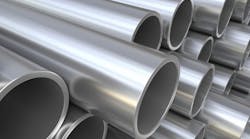Behind the scandal engulfing Kobe Steel Ltd. over the falsification of data for some of the materials it supplied is a harsh reality for Japanese steel companies: the need to provide higher and higher quality metals to compete.
Kobe Steel rocked Japan’s industrial economy with revelations this week that it faked data on the quality of some aluminum, copper and iron powder sales. Chief Executive Officer Hiroya Kawasaki said more cases could emerge as the company continues its investigations. Among those affected are automakers -- among the biggest customers for steel producers -- who have been seeking more advanced products to cut weight while retaining strength and versatility.
“The steelmakers are really trying to protect their turf, because this is a life-and-death situation for them,” said Thanh Ha Pham, senior vice president in Japan for investment bank Jefferies Group LLC. “It’s improve or die.”
The trade-off for carmakers between a vehicle that’s strong enough to be safe but light enough to be energy-efficient has led to an array of alloys and efforts to break the dominance of steel, from McLaren’s iconic carbon-fiber F1 supercar in the 1990s to Ford Motor Co.’s decision to switch its venerable F150 pick-up to aluminum in 2015.
While Kobe Steel’s falsified reports may be an isolated incident in the industry, Japan’s steelmakers have spent a fortune developing new types of steel and other metals to meet demands from automakers for fuel-efficiency, whether the car has a 300 kilogram petrol engine under the hood, or a 300 kilogram lithium-ion battery. About two-thirds of the weight of most vehicles is still steel.
Is Steel Reaching Its Limit?
But some in the industry see a limit to how thin steel can go, because it would need to be so rigid that it can no longer be molded into car parts.
“We can keep going like this for another 10 years” said Toshinao Minakuchi, head of the automotive steel sheet technical solutions department at Nippon Steel & Sumitomo Metal Corp. “But at some point, the limit is coming for steel.”
Nippon Steel, Japan’s top producer, is working to improve both the strength and formability of its high-tensile steel by 20% to 30% over the next five to 10 years and is also conducting research on mixing steel with other materials.
A Nippon Steel spokeswoman said the company isn’t in a position to comment on the quality issue, saying that it isn’t involved in aluminum and copper products.
The pressure for ever-lighter, thinner and stronger materials has prompted an increase in the use of other metals, such as aluminum, as well as advanced polymers and carbon fiber. Materials companies including DSM NA and Teijin Ltd. are to trying to marry the properties of steel and plastics by developing a new generation of hybrid products that integrate the two.
'Fusion is the Future'
“Fusion is the future,” said Yuji Nakamura, president of DSM’s Japan unit, which is working with steelmakers on some projects. He predicts the plastic content of vehicles will rise to 25% by 2030, from about 15% now. “All parts of the car should be multi-material composites going forward: the right material in the right place.”
Kobe Steel said more than 200 customers, which it didn’t identify, were sold products that failed quality control tests, but there have been no reports of safety issues. A spokesman for the company said pressure to meet delivery deadlines was one reason behind the failure, but the incident is linked to the company’s quality management, not its customers.
As countries such as China, India and the U.K. announce plans to phase out fossil fuel-powered vehicles, the pressure on steelmakers may accelerate as carmakers try to shed weight to extend the driving range of each battery charge. Even California, the largest car market in the U.S., is mulling a bar on the sale of vehicles powered by internal-combustion engines, according to Mary Nichols, chairman of the California Air Resources Board.
The use of plastic in cars isn’t new. Fiberglass and plastic panels have been used in cars for decades, from the much vilified East German Trabant of the 1950s, to high-tech Formula 1 race cars and the recent first efforts to make car bodies with 3-D printers.
But none is yet able to match the cost and versatility of steel. Carbon fiber is 10 times stronger than steel, but up to 18 times more expensive, according to SBI Securities Co. It’s as much as six times more costly than aluminum.
“Ten years ago I thought steel must getting close to its limit, but instead Japan’s steelmakers just kept persevering,” said Yasunari Hotani, general manager of auto business development group at Teijin. “I never expected they would be able to do so much.”
By Kevin Buckland and Masumi Suga



